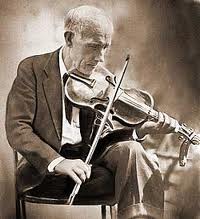Annotation:Washington's March (3): Difference between revisions
(Created page with "=='''Back to [[{{BASEPAGENAME}}]]'''== ---- <p><font face="garamond, serif" size="4"> '''WASHINGTON’S MARCH [3].''' Old Time, Breakdown. USA, West Virginia. D Major. DDad tu...") |
No edit summary |
||
| Line 2: | Line 2: | ||
---- | ---- | ||
<p><font face="garamond, serif" size="4"> | <p><font face="garamond, serif" size="4"> | ||
'''WASHINGTON’S MARCH [3].''' Old Time, Breakdown. USA, West Virginia. D Major. DDad tuning (fiddle). AA’. Despite the title, the tune is played in reel tempo. May possibly be a very distant derivative of “[[Washington’s Grand March]],” although there were many melodies in America that carried the Washington name, an indication of his influence even in backwoods areas. Betty Vornbrock notices a similarity in the high part of Hammons’ version and the ‘B’ part of the Shetland tune “[[Sleep Soond i’da Moarnin’]]”. Allan Jabbour (in 1984 notes to Edden Hammons recording) says that this is one of the tunes in the Hammons family repertoire that has special family associations, in that it was considered to have been composed by early family members, “or at least uniquely preserved by them.” The original 1947 field recorder, a folklorist named Louis Watson Chappell, stated that Edden Hammons won the 1939 Greenbrier Valley fiddle championship playing “Washington’s March,” and the he had learned it “59 years ago and first played it on a gourd covered by a deer skin” (quoted by Jabbour). Randolph County, West Virginia, fiddler Woody Simmons (b. 1911) remarked in a 1979 interview for '''Goldenseal Magazine''':[[File:edden.jpg|200px|thumb|left|Edden Hammons ()]] | '''WASHINGTON’S MARCH [3].''' Old Time, Breakdown. USA, West Virginia. D Major. DDad tuning (fiddle). AA’. Despite the title, the tune is played in reel tempo. May possibly be a very distant derivative of “[[Washington’s Grand March]],” although there were many melodies in America that carried the Washington name, an indication of his influence even in backwoods areas. Betty Vornbrock notices a similarity in the high part of Edden Hammons’ [http://www.oldtimemusic.com/FHOFEdn.html] version and the ‘B’ part of the Shetland tune “[[Sleep Soond i’da Moarnin’]]”. Allan Jabbour (in 1984 notes to Edden Hammons recording) says that this is one of the tunes in the Hammons family repertoire that has special family associations, in that it was considered to have been composed by early family members, “or at least uniquely preserved by them.” The original 1947 field recorder, a folklorist named Louis Watson Chappell, stated that Edden Hammons won the 1939 Greenbrier Valley fiddle championship playing “Washington’s March,” and the he had learned it “59 years ago and first played it on a gourd covered by a deer skin” (quoted by Jabbour). Randolph County, West Virginia, fiddler Woody Simmons (b. 1911) remarked in a 1979 interview for '''Goldenseal Magazine''':[[File:edden.jpg|200px|thumb|left|Edden Hammons (1874-1955)]] | ||
<blockquote> | <blockquote> | ||
''[Edwin Hammons] made that old “George Washington March” up'' | ''[Edwin Hammons] made that old “George Washington March” up'' | ||
Revision as of 01:59, 2 July 2015
Back to Washington's March (3)
WASHINGTON’S MARCH [3]. Old Time, Breakdown. USA, West Virginia. D Major. DDad tuning (fiddle). AA’. Despite the title, the tune is played in reel tempo. May possibly be a very distant derivative of “Washington’s Grand March,” although there were many melodies in America that carried the Washington name, an indication of his influence even in backwoods areas. Betty Vornbrock notices a similarity in the high part of Edden Hammons’ [1] version and the ‘B’ part of the Shetland tune “Sleep Soond i’da Moarnin’”. Allan Jabbour (in 1984 notes to Edden Hammons recording) says that this is one of the tunes in the Hammons family repertoire that has special family associations, in that it was considered to have been composed by early family members, “or at least uniquely preserved by them.” The original 1947 field recorder, a folklorist named Louis Watson Chappell, stated that Edden Hammons won the 1939 Greenbrier Valley fiddle championship playing “Washington’s March,” and the he had learned it “59 years ago and first played it on a gourd covered by a deer skin” (quoted by Jabbour). Randolph County, West Virginia, fiddler Woody Simmons (b. 1911) remarked in a 1979 interview for Goldenseal Magazine:

[Edwin Hammons] made that old “George Washington March” up himself. One day I said, “Edwin, play me that ‘George Washington March.’” He said, “I’ll play her for you, but I won’t play her fer—he called Dewey Hamrick ‘Jewey’—he said, “I won’t play her fer Jewey, but I’ll play her for you.” And he did, he played me the “George Washington March,” and I learned it from him. I won a fiddlers’ contest in Glenville with it. I could never win nothing at Glenville (the West Virginia State Folk Festival), only with the old “George Washington March.” You tune the fiddle altogether different to play that. Edwin Hammons would drop the G string down to D, and the E string down to D. (Mountains of Music, 1999, John Lilly ed., p. 22)
The melody was also played in this tuning by eastern Kentucky fiddler Ed Haley. Source for notated version:
ntas County, West Virginia) [Krassen].
Printed sources: Krassen (Masters of Old Time Fiddling), 1983; p. 81.
Recorded sources: WVU Press SA-1, “Edden Hammons Collection I” (1999). Yazoo 2103, Eddon Hammons – “American Rural Classics 1927-37.”
